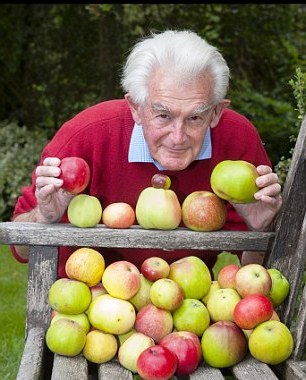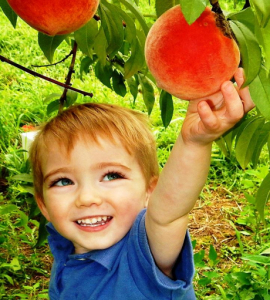By Ken Lain, the mountain gardener
You used to need a lot of land to grow fruit trees. Most standard-sized fruit trees mature at a height and width of between 18-25 ft. Not only will this require a big chunk of your garden, but it also makes them tall to prune and spray without the use of a ladder. Dwarf and semi-dwarf fruit trees have made it possible to grow them in just about any yard.

Even with smaller trees, growing fruit is a long-term investment. It can take anywhere from 2 to 10 years for fruits to begin bearing. If you plan to be harvesting for years to come, it pays to do some planning upfront
Choosing a Size – The terms dwarf and semi-dwarf can be a bit confusing. Dwarf fruit trees reach a height and width of about 8-10 ft. At this height, they can be tended and harvested without a ladder. Pruning can keep them even smaller. Unfortunately, dwarf fruit trees tend to be short-lived.
Semi-dwarf fruit trees are a little larger at maturity, with most topping at 12-16 ft. tall and wide. Maintenance and harvest require a ladder, but the average harvest is 8 – 12 bushels, about twice what you’d get from a dwarf tree.
There’s not much space difference between the two types of trees, and both should start producing fruits within 2 – 5 years. The question you have to ask yourself then is, are you willing to work a little harder to get a more abundant harvest, or will you be content with a moderate crop within arm’s reach?
For those of you thinking that even 8-10 ft. is more space than you have or can sacrifice, don’t give up. Fruit trees can be grown in containers as well. The yield is not as heavy, but every bit of delicious.
Which Fruit Trees Need Pollinators? Most fruit trees produce better fruits if there are two or more trees planted nearby. Anywhere in the landscape will do, just don’t put your house between the two trees.
Although the trees need to be the same type of fruit, they should not be the same variety. You can plant two different kinds of apples, and they will cross-pollinate each other, as long as they bloom at the same time. Most fruit tree catalogs and plant labels give you suggestions for excellent pollinators. We have several local charts here at Watters that will help.
If you only want one tree, your best options are peach, apricot, nectarine, and sour cherry. These fruits are self-pollinating or self-fruitful, meaning they can pollinate themselves with help from local bees. One notable exception is Stella sweet cherry that is also self-fruitful.
A second option is a multi-grafted tree, where three or more varieties of apples are grafted onto one trunk.
Some Like it Cold – Deciduous fruit trees need a certain number of hours where the temperature is below 45 F. Without this chilling period during their dormancy, trees set limited fruit the following spring. We have locally proven varieties available here at the garden center.
Which Fruit Trees are Low Maintenance? All fruit trees require some care and feeding. Most require annual pruning. However, some can get by very well with minimal supervision once established. At the top of the list of low maintenance trees are cherries. These require pruning only when branches are damaged or crossing.
Stone fruits like peaches, apricots, and nectarines are not maintenance-heavy either. Some pruning is required to keep the trees open to light and probably need fruit thinning in early summer for a healthy harvest.

Apples and pears are the best mountain producers. Late frost just as the fruit is forming will thin the fruit set. Because apples and pears are the very last trees to blossom in spring, it reduces the likelihood of frost damaging the fruits. This one trait puts them in the number one producer spot.
Pruning fruit trees is a vast topic unto itself and will vary with the type of tree. But starting with the right tree for your location and getting it off to a healthy start is a solid first step toward your first fruit harvest.
Plant before they leaf. Late winter and early spring are the ideal planting window for fruit trees. We have the best local selection now, and they wake up ready to set fruit and grow before they bloom. If you’re thinking fruit this spring, now is the time to plant.
Fruit Tree Class here at Watters. February 8th @ 9:30 am, will cover all the local fruit tree opportunities. Learn the insiders’ tips from the pros who know varieties, planting techniques, food, and more. Get ready for a blockbuster harvest this year. We cover local success stories, best types, and how to prune each variety.
Until next week, I’ll be helping gardeners choose the perfect fruit trees at Watters Garden Center.
Ken Lain can be found throughout the week at Watters Garden Center, 1815 W. Iron Springs Rd in Prescott, or contacted through his web site at WattersGardenCenter.com or FB.com/WattersGardenCenter .


Do you have a list of fruit trees best for Prescott AZ. I live in Fort Davis, TX. We are one mile high and frequently get late April freezes where I loose all my cherries, apricots, and blackberries. What late blooming Apricot do you recommend? I think our climates are quite similar.
If you go to our website, there is a list of several fruit trees that grow well in our area (under the Learning Tab). this was also covered in a recent YouTube video that is available on our YouTube Channel.